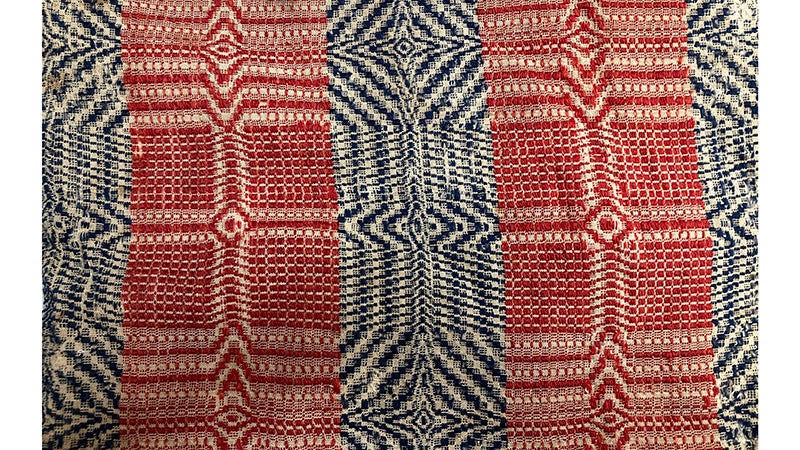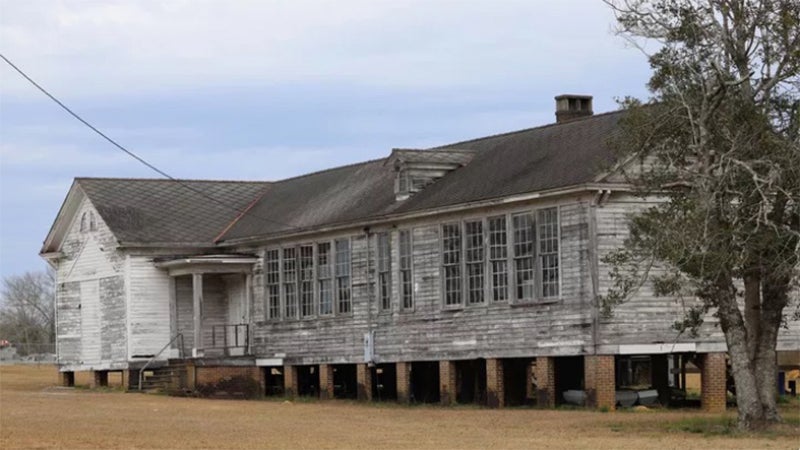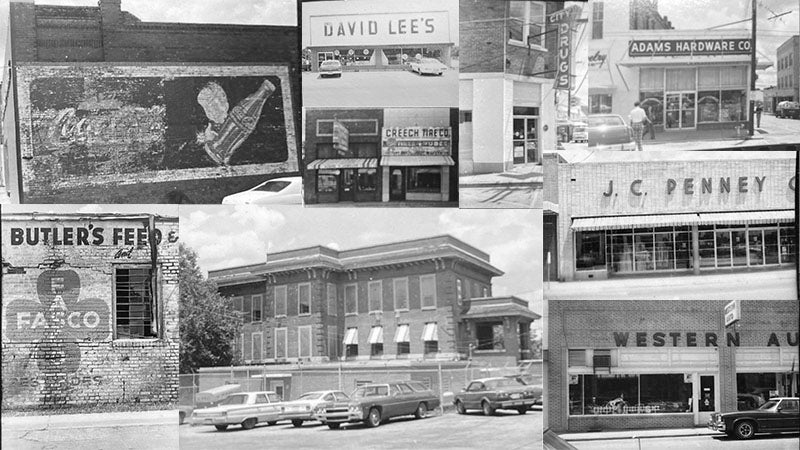Remember when: From gulley to stadium
Published 2:09 am Saturday, August 18, 2018
From a caterpillar to a butterfly; from a frog to a prince; from Cinderella to a princess; from a gulley to a stadium! Yes, the gulley on the east side of town was written about by one of the town’s historians, Sidney Waits who grew up in the 1930s and 1940s.
“The small gulley was located in the rear of the new high school property where the present stadium and parking lot were built – the high school building completed in 1939 and the stadium and parking lot built in 1950.”
“Sometimes,” Waits recalled, “my friends and I would ride our bikes or we would just enjoy walking to the gulley to play. I believe it must have been about 8 or 10 feet deep and several feet wide. Most of the neighborhood children enjoyed the gulley. It was quite evident when the school opened in 1939. Some of the early athletic events were played on fields east of the school as the gulley that sloped way down made it impossible to play games there.”
“One of those early games was between Andalusia and Opp. It was highly contested and a great rivalry. Following the game, some of our students painted the score in big letters on the fence nearing the entrance to the east entrance of the school. It was a prominent location and anyone entering the school would see the artwork.”
“Needless to say, ‘Jeep’ (oops, Principal J. H. Johnson) was upset over the letters portraying the score. With his usual ability to snuff out the evidence, he called the accused foursome to his office and lectured them sternly. He told them he wanted that sign removed where you could no longer read it.”
“The foursome got their heads together and decided what they had to do to comply with ‘Jeep’s’ request. Painting would require a lot of high priced paint and would be rather messy. They (or was it ‘we’) decided that the only way they could fix it would be to take off some of the boards, turn them over, and re-nail in place. So they did just that!”
“All they had to work with was a hammer, so they began. They took off every other board, turned each one over, and re-nailed them in place. This made the sign a jigsaw puzzle making it impossible to read. This met ‘Jeep’s’ demand, and the entire fence did not have to be painted. This foursome was Andy’s brightest and smartest!”
“The first thing the next morning, the foursome was back in the principal’s office. ‘Jeep’ began criticizing what had been done and was about to prescribe additional punishment. One of the foursome pointed out in an innocent way, ‘Now you wanted us to do whatever had to be done to the sign on the fence so it could not be read. We did that and you certainly can’t read it now!’”
“With that ‘Jeep’ sorta cooled down and told the foursome to go on back to their classes. The mixed-up lettering was on that fence until they finally tore the fence down. No one could even begin to read the score. Only scrap pieces of the sign were visible.”
I guess every generation or every class has a “stadium” story of one kind or another. It might be remembrances of the spring track meets that were regularly hosted there, the football practices and Andy Hi football games, the all-night gospel singings, CCTS football games, the traveling entertainment hosted in the 1950s by the Jaycees (Jr. Chamber of Commerce), the AHS band concerts, and the graduation exercises held there before the auditorium was completed in December 1963.
One summer some of my Class of 1965 classmates and I decided that since most of the school classes had painted in tall letters their class years on the concrete block wall on the north side of the stadium, it was high time that our class year should appear. “Well,” we told ourselves when we were about juniors, “it is our turn to display ‘65’ on the wall.” So late one summer before school started, we walked all over the neighborhood searching for supplies and finally found some lime green paint in one of the father’s garages. We, all five or six of us, mostly neighborhood friends, I’ll say, headed one dark summer’s night, on foot, straight to the stadium. Paint brushes in hand, we somehow made our way into the stadium, it was easy back then, and painted in big wide sweeping motions our class year on that wall. Can’t remember if the paint was oil base or latex! We didn’t care! It was just our way of living up to what some of our parents predicted back when we were between the sixth and seventh grades – “That Class of ’65 is going to be the wildest one yet!” I don’t know what they were thinking when all we did back then was crash a tent revival in our beatnik costumes coming from a birthday party!
The next football season, it must have been the fall of 1964, “65” was up there along with 64, 63, 62, 61, and other class years. The tradition continued! When the band would play, we would look at each other, glance across the field at our green artwork on the fence between, “Hoorah for Andy,” “Corn, Corn,” and smile! Can’t remember how long all those class year numbers remained on “the wall,” but it was for a pretty long stretch of years! The wall was finally painted black. Until the wall was recently torn down, my friends and I knew exactly where our letters were.
The original main building, “Old Main,” as it came to be known was completed in 1939. Built during the end of the Depression years by Andalusia Development Company under the WPA program, the municipal stadium was designed out of a natural cave according to one of the builders, A. Reid Merrill. The Works Progress Administration, the largest and most ambitious American New Deal agency which employed millions all over the country to carry out public works projects, made it possible to build the new high school now needed for a growing number of elementary age students and high schoolers. (A new elementary school was needed so Church Street School was converted from the high school to another elementary school.) AHS was built on the site of the old John Chapman family farm whose pecan orchard can still be seen in the neighborhood yards all the way from the school to East Three Notch Street down 3rd, 2nd, and 1st Avenues.
Merrill once told this writer and an audience of the historical society that a family actually lived during those hard economic times in the gulley cave. He witnessed this first hand during the time that his company was in the process of building the high school.
Another story that was told to me the other day by Robert Cremer was typical of the bicycle boys of the 1950s. Robert, who was probably not even 10 years old at the time, said that after the Friday night home football games, he and a neighborhood friend would get up early on Saturday mornings and go to the stadium. They would go to the concession stands and feel around under the counters and drink boxes gathering up all the change they could find – nickels, dimes, quarters that had been dropped the night before. They might find enough money, sometimes two dollars and fifty cents, if they were lucky, to go to the picture show and buy candy, popcorn, and drinks and even comic books at the drug store! Now that’s a memory!
There are sure to be many stories and tall tales that come from the tedious planning and construction of the new AHS stadium complex. It is hard to believe that over 68 years ago, the stadium was first built, a “municipal” stadium at that time. There must have been someone with a vision to view that gulley and see the potential for a stadium.
Now we are into the era of drones, astro-turf, modern engineering and architectural techniques, electronic scoreboards, innovative concession stands, and technically savvy press boxes. Whenever it is completed and dedicated, our town should be immensely proud. We should Remember When it was once a gulley and be proud of its transformation into a first-class landmark stadium that will be used and enjoyed for many years to come!
Sue Bass Wilson, AHS Class of 1965, and long-time member of the Covington Historical Society, can be reached at suebwilson47@gmail.com.

The original marker for Municipal Stadium is now in the Heritage Room at AHS. Joe Wingard started the Heritage Room, with support from the Class of ‘48 Foundation (now Andalusia High School Scholarship Foundation). Sue WIlson recently was named curator.
Courtesy Photo





